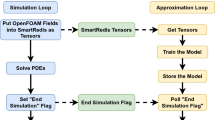Abstract
This paper describes problems, challenges, and opportunities forintelligent simulation of physical systems. Prototype intelligent simulation tools have been constructed for interpreting massive data sets from physical fields and for designing engineering systems. We identify the characteristics of intelligent simulation and describe several concrete application examples. These applications, which include weather data interpretation, distributed control optimization, and spatio-temporal diffusion-reaction pattern analysis, demonstrate that intelligent simulation tools are indispensable for the rapid prototyping of application programs in many challenging scientific and engineering domains.
Similar content being viewed by others
References
Abelson, H.,et al., “Intelligence in Scientific Computing,”CACM,32,5, 1989.
Air Weather Service, “Back to Basics,” inAWS FOT Seminar STT-Q9-0004, 1975.
Arnold, V.,Ordinary Differential Equations, MIT Press, 1987.
Bailey-Kellogg, C. and Zhao, F., “Qualitative Analysis of Distributed Physical Systems with Applications to Control Synthesis,” inProc. of AAAI, 1998.
Bailey-Kellogg, C. and Zhao, F., “Influence-based Model Decomposition,” inProc. of AAAI, to appear, 1999.
Bailey-Kellogg, C., Zhao, F. and Yip, K., “Spatial Aggregation: Language and Applications,” inProc. of AAAI, 1996.
Bobrow, D.,et al., “A Compositional Modeling Language,” inWorking Papers of Qualitative Reasoning Workshop, 1996.
Böhringer, K.-F. and Donald, B., “Algorithmic MEMS,” inThird International Workshop on the Algorithmic Foundations of Robotics (WAFR), 1998.
Bradley, E. and Zhao, F., “Phase-space Control System Design,”IEEE Control Systems 13, 2, pp. 39–47, 1993.
Briggs, W.,A Multigrid Tutorial, Lancaster Press, 1987.
Chan, T. and Mathew, T., Domain Decomposition Algorithms,vol. 3 of Acta Numerica, Cambridge University Press, pp. 61–143, 1994.
Falkenhainer, B. and Forbus, K., “Compositional Modeling: Finding the Right Model for the Job,”Artificial Intelligence, 51, 1991.
Fayyad, U., Haussler, D. and Stolorz, P., “KDD for Science Data Analysis: Issues and Examples,” inProc. of 2nd International Conference on Knowledge Discovery and Data Mining (KDD-96), 1996.
Forbus, K., Nielsen, P. and Faltings, B., “Qualitative Spatial Reasoning: the CLOCK Project,”Artificial Intelligence, 51, 1991.
Glasgow, J., Narayanan, N. and Chandrasekaran, B., (editors),Diagrammatic Reasoning: Cognitive and Computational Perspectives, AAAI Press, 1995.
Joskowicz, L. and Sacks, E., “Computational Kinematics,”Artificial Intelligence, 51, pp. 381–416, 1991.
Kailath, T.,et al., “Control for Advanced Semiconductor Device Manufacturing: A Case History,” inThe Control Handbook (W. Levine, editor), CRC Press, 1996.
Lozano-Perez, T., “Spatial Planning: a Configuration-space Approach”IEEE Trans. Comput.,71,7, 1983.
Lu, W., Han, J. and Ooi, B., “Discovery of General Knowledge in Large Spatial Databases,” inProc. of Far East Workshop on Geographic Information Systems, 1998.
Metropolis, N.,et. at, “Equation of State Calculations by Fast Computing Machines,”Journal of Chemical Physics, 21, pp. 1087–1092, 1953.
Nishida, T., et al., “Automated Phase Portrait Analysis by Integrating Qualitative and Quantitative Analysis,” inProc. of AAAI, 1991.
Rosenblum, L.,et al., ed.,Scientific Visualization: Advances and Challenges, Academic Press, 1994.
Sacks, E., “Automatic Analysis of One-parameter Planar Ordinary Differential Equations by Intelligent Numerical Simulation,”Artificial Intelligence, 51, pp. 27–56, 1991.
Samtaney, R., Silver, D., Zabusky, N. and Cao, J., “Visualizing Features and Tracking Their Evolution,”IEEE Computer Magazine, 1994.
Ullman, S., “Visual Routines,”Cognition, 18, 1984.
Williams, B. and Nayak, P., “Immobile Robots: AI in the New Millenium,”AI Magazine,17,3, 1996.
Yip, K.,KAM: A System for Intelligently Guiding Numerical Experimentation by Computer, MIT Press, 1991.
Yip, K., “Reasoning about Fluid Motion: Finding Structures,” inProc. of IJCAI, 1995.
Yip, K. and Zhao, F., “Spatial Aggregation: Theory and Applications,”Journal of Artificial Intelligence Research, 5, 1996.
Zhao, F., “Extracting and Representing Qualitative Behaviors of Complex Systems in Phase Spaces,”Artificial Intelligence, 69, 1–2, pp. 51–92, 1994.
Author information
Authors and Affiliations
Additional information
Feng Zhao, Ph.D.: He leads Smart Matter Diagnostics Project at Xerox PARC. He has also been an Associate Professor of Computer and Information Science at Ohio State University and leads the Intelligent Simulation Group. His research interests include artificial intelligence, scientific computing, hybrid systems, and applications to problems in nonlinear dynamics and control. Zhao received PhD and MS in Electrical Engineering and Computer Science from M.I.T. At Xeron PARC and Ohio State, he led the development of Spatial Aggregation Technology and a software tool SAL to support data modeling and optimization for distributed applications. He is an Alfred P. Sloan Research Fellow and received the NSF and ONR Young Investigator Awards. He has authored or co-authored about 50 technical papers.
Chris Bailey-Kellogg, Ph.D.: He is a postdoc in Prof. Bruce Donald’s lab at Dartmouth, where he is applying intelligent simulation-like techniques to computational molecular biology problems, including automated interpretation of protein NMR data and computational drug design. He conducted his PhD research at Ohio State and Xerox PARC with Prof. Feng Zhao. For his dissertation, he implemented the Spatial Aggregation Language interpreter and used it to develop novel algorithms for decentralized control design for distributed parameter systems. He enjoys building tools that mix techniques from artificial intelligence, geometric reasoning, and scientific computation, in support of science and engineering applications.
Xingang Huang: He received a B.S. degree in computer science from Huazhong University of Science and Technology (China) in 1992, and a M.S. degree in computer science from the Institute of Computing Technology, Academia Sinica (China). Mr. Huang joined the Department of Computer and Information Science at the Ohio State University in 1995 and is now a Ph.D. candidate and research assistant. He is a member of AAAI. His research interests are intelligent data analysis, spatial reasoning and computer vision.
Iván Ordóñez-Reinoso: He was born in 1965 in Guayaquil, Ecuador. He holds a Professional degree in Electrical Engineering from the National Polytechnic School (Quito, Ecuador) and a Master’s degree in Computer Science from the Monterrey Institute of Technology (Monterrey, Mexico). He is currently a Ph. D. student at the Ohio State University, CIS Department. His research interests include spatiotemporal reasoning and morphogenesis in dynamical fields.
About this article
Cite this article
Zhao, F., Bailey-Kellogg, C., Huang, X. et al. Intelligent simulation tools for mining large scientific data sets. NGCO 17, 333–347 (1999). https://doi.org/10.1007/BF03037240
Received:
Revised:
Issue Date:
DOI: https://doi.org/10.1007/BF03037240




